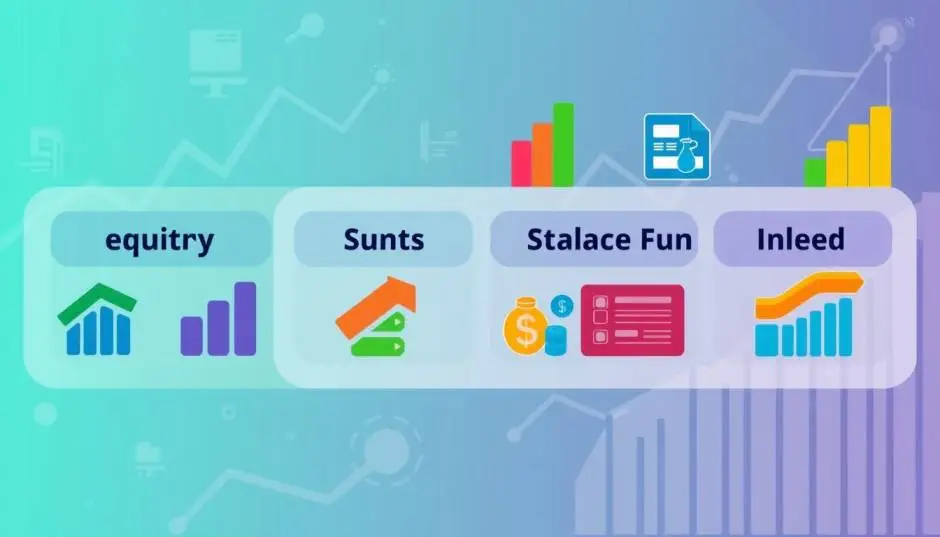As an investor, you have many options to build a diversified portfolio. Mutual funds are a popular choice. They offer a convenient way to invest in a wide range of assets. We’ll look at the different types of mutual funds, their key features, and how they can help your investment strategy.
Key Takeaways
- Mutual funds provide access to a diversified portfolio of investments, managed by professional fund managers.
- There are various types of mutual funds, including equity, fixed income, and specialized funds, each with its own risk-return profile.
- Understanding the different mutual fund categories can help you align your investments with your financial goals and risk tolerance.
- Mutual funds offer the benefits of professional management, diversification, and access to a wide range of asset classes.
- Researching and selecting the right mutual funds for your portfolio can be a key strategy in achieving your investment objectives.
Understanding Mutual Fund Basics and Their Role in Investment
Mutual funds are a common way to invest money. They combine funds from many investors into one portfolio. This portfolio includes stocks, bonds, or both. Knowing how mutual funds work is key to smart investing.
Key Components of Mutual Fund Structure
The main parts of a mutual fund are:
- Fund Manager: This person decides which securities to buy and sell.
- Net Asset Value (NAV): It’s the value of each share, based on the fund’s assets and shares.
- Expense Ratio: This is the yearly fee for managing the fund.
How Mutual Funds Generate Returns
Mutual funds make money in two ways: through growth and income. Equity funds grow your money by investing in stocks. Debt funds earn income from bonds. Balanced funds mix both, aiming for steady income and some growth.
Benefits of Mutual Fund Investing
Investing in mutual funds has many advantages, including:
- Diversification: Spreading your money across many securities lowers risk.
- Professional Management: Skilled managers pick the best securities for you.
- Liquidity: You can easily buy and sell shares, giving you quick access to your money.
- Affordability: You can start investing with a small amount of money.
“Mutual funds are a great way for investors to access the financial markets and build wealth over the long term.”
What are different types of mutual funds available?
There are many mutual fund options to choose from. You can pick from money market funds, index funds, or sector funds. Each type offers a chance to match your investments with your financial goals.
Equity funds focus on stocks. They can be growth, value, or blend funds. Each has its own way of investing and risk level.
Fixed-income or debt funds invest in bonds. They offer a stable, income-generating choice. This group includes government, corporate, and municipal bond funds.
Hybrid funds mix equity and debt. They aim for a balanced portfolio. Examples are balanced, asset allocation, and target-date funds.
Specialty funds meet specific investment needs. They include money market funds, index funds, and sector funds. These target certain industries or market segments.
| Fund Type | Description | Examples |
|---|---|---|
| Equity Funds | Invest primarily in stocks | Growth Funds, Value Funds, Blend Funds |
| Debt/Fixed-Income Funds | Invest primarily in bonds and fixed-income securities | Government Bond Funds, Corporate Bond Funds, Municipal Bond Funds |
| Hybrid Funds | Combine both equity and debt investments | Balanced Funds, Asset Allocation Funds, Target-Date Funds |
| Specialty Funds | Cater to specific investment preferences | Money Market Funds, Index Funds, Sector Funds |
Knowing about the different mutual funds helps investors create a portfolio that fits their needs. It’s all about matching your risk level, goals, and financial situation.
“The beauty of mutual funds is that they let you diversify your portfolio through a single investment, making them an excellent option for investors of all experience levels.”
Equity and Debt Mutual Funds Deep Dive
Investing in mutual funds gives you many options, like equity and debt funds. Knowing the differences between these funds helps you make better choices. It also helps you create a balanced investment portfolio.
Growth vs. Value Equity Funds
Equity mutual funds fall into two main types: growth and value funds. Growth funds look for companies with high growth potential. Value funds find undervalued stocks. Your choice depends on how much risk you’re willing to take and what you want to achieve.
Government and Corporate Debt Funds
Debt mutual funds offer a variety of fixed-income securities. Government debt funds mainly invest in government bonds, seen as safer. Corporate debt funds focus on company bonds, offering higher yields but with more risk.
Risk-Return Analysis of Different Fund Types
When picking mutual funds, think about the risk and return balance. International funds and target-date funds might offer more returns but also more risks. Always consider your risk tolerance and goals before choosing the right funds for you.
“Investing in a variety of mutual fund types can help you build a diversified portfolio and achieve your long-term financial goals.”
Specialized Mutual Fund Categories and Investment Strategies
As an investor, you have many mutual fund options beyond the usual equity and debt funds. These specialized funds help diversify your portfolio and aim for specific goals. Let’s look at sector funds, international funds, and target-date funds.
Sector Funds: Targeted Exposure
Sector funds focus on a specific industry or market sector, like technology, healthcare, or real estate. They let you invest in areas that match your investment goals. By choosing sector funds, you can tap into the growth of certain industries and spread out your investments.
International Funds: Global Diversification
International funds invest in companies outside your home country, offering global market exposure. They help diversify your portfolio and can find opportunities in different economies. But, remember, international investing comes with risks like currency changes and political issues.
Target-Date Funds: Life-Stage Planning
Target-date funds adjust their mix of investments as you get closer to retirement. They’re great for those who don’t want to manage their retirement savings themselves. By investing in a target-date fund, your portfolio will automatically adjust to your risk level and retirement timeline.
Looking to focus on certain sectors, diversify globally, or plan for retirement? These specialized mutual fund categories offer unique strategies. Always research and understand the risks and rewards of each fund before investing.
“Investing in specialized mutual funds can be a powerful way to fine-tune your portfolio and pursue specific investment goals.”
Conclusion
The world of mutual funds is full of choices to fit your investment needs. You can find everything from equity and debt funds to special categories. This variety helps you build a portfolio that matches your goals and risk level.
Looking for growth, income, or a mix? There’s a mutual fund for you. Knowing about mutual fund categories and their features helps you choose wisely. This way, you can reach your financial goals.
Keep in mind, not all mutual funds are the same. Think about your risk tolerance, how long you can invest, and your financial goals. By doing this, you can pick the right funds for your journey in the market.
FAQ
What are the different types of mutual funds available?
Investors can choose from many mutual funds. These include equity, debt, balanced, money market, index, sector, international, and target-date funds. Each has its own goals, risk levels, and potential gains.
What are equity funds?
Equity funds mainly invest in stocks. They aim for long-term growth. They can be growth, value, or a mix of both.
What are debt funds?
Debt funds buy fixed-income securities like government and corporate bonds. They offer steady income but less chance for growth.
What are balanced funds?
Balanced funds mix stocks and bonds. They aim for a balance between growth and income. They’re good for those wanting a mix of risk and return.
What are money market funds?
Money market funds invest in short-term, safe securities. They’re for those who want stable value and income. They’re great for low-risk investors or those needing quick cash.
What are index funds?
Index funds follow a market index like the S&P 500. They aim to match the index’s returns. They often have lower fees than actively managed funds.
What are sector funds?
Sector funds focus on a specific industry or sector. They let investors target areas they think will do well. This can be tech, healthcare, or energy.
What are international funds?
International funds invest in companies outside the investor’s country. They offer global market exposure and diversification. But, they also come with risks like currency changes and political issues.
What are target-date funds?
Target-date funds are for those with a specific goal, like retirement. As the goal date nears, the fund’s risk decreases. This helps manage risk over time.



